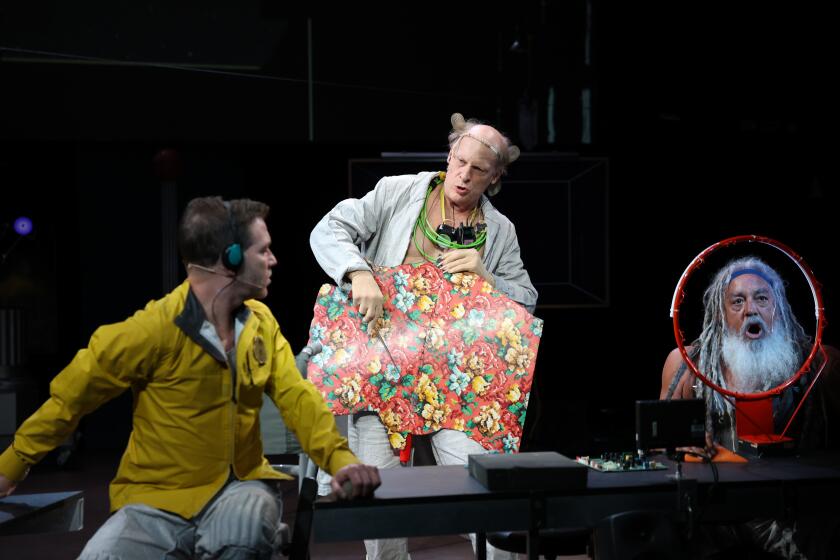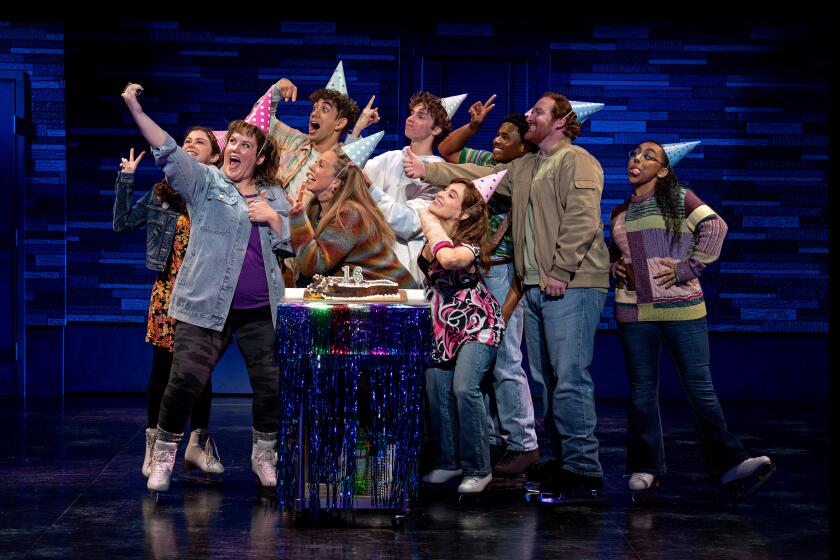‘YOU CAN’T TAKE IT WITH YOU’ OPENS TONIGHT : HIGH-TECH FIRM NURTURES ACTING BUG
The scientific realm of high-tech robotics and aerospace engineering might seem ill-suited for the likes of Kaufman and Hart or any of the other greats of the American theater.
But for a couple of months each year at Odetics Inc., an Anaheim firm specializing in advanced electronics, a drama script becomes as significant as a feasibility report for a small group of employees.
That’s when the Odetics Repertory Theatre begins rehearsals for its annual production. This year’s show is Kaufman and Hart’s breezy 1937 Pulitzer Prize winner “You Can’t Take It With You,” which will open tonight at the Servite Theatre at Servite High School in Anaheim.
Odetics Repetory was established in 1980 as “more or less of a morale booster (designed to) bring a sense of fun to the workplace and promote camaraderie,” said Joel Slutzky, Odetics’ chief executive officer.
What started out as an experiment in personnel relations soon became something of an in-house hit. The first show, “You’re a Good Man Charlie Brown,” got such a positive response that Odetics presented “The Good Doctor” the following year and “Ernest in Love” in 1983.
The repertory theater, which is funded by Odetics Inc. and ticket sales, is open to all employees who are willing to rehearse after work. Auditions are held at the beginning of each year and attract a diverse group ranging from mechanical design engineers and contract managers to stockroom clerks. Most of the performers have little or no acting experience outside the theater group, noted Judy Artunian, the repertory’s publicity officer.
“This is just something they do here because they like it so much,” she said. “It brings out the ham in most of them.”
Wayne Holly, an engineer in the AIM (Advanced Intelligent Machines) division and director of “You Can’t Take It With You,” agreed.
“I think many of them get in this because they are curious, (and they) don’t really know what to expect,” he said, “but they get turned on to it, and from there it turns into something they’re hooked on. People are exhibitionists, aren’t they?”
Holly, while readily conceding that these are amateur productions that can’t compete with more established repertories, stressed that the actors and stage crew have a serious attitude. The rehearsals--three nights a week for about two months--are strenuous, and the performers have to satisfy a tough audience when the play is finally ready, he said.
More than half the spectators for any performance are usually Odetics employees and their family members--it’s a group that, while encouraging, can be difficult to please.
“They watch us pretty closely, I think,” said Dan Thomas, a contracts manager for the Spaceborne division, who has the role of oddball Paul Sycamore. “If we mess up, they notice. We don’t want to come across as fools (in front of our colleagues) . . . I see us as amateur in standing but professional in our hearts.”
Besides the challenges, one of the attractive things about the repertory theater, said its members, is that all class distinctions quickly become blurred. A department head might have to defer to a clerk once rehearsals get under way, Holly said.
This helps to create the friendly social atmosphere that Nadine Binger, a market analyst for the AIM division who plays the ballet-obsessed Essie, was looking for. A relative newcomer to Odetics, Binger wanted to meet more people and found the theater group to be the right outlet.
“It has given me a great opportunity to get more involved; I think a lot of us feel that way,” she said.
Binger noted that she was particularly drawn to “You Can’t Take it With You” because of its message. The play, which follows the eccentric lives of the Sycamore family during the Depression, tells people that “anything is possible, that you can do what you want if you put your mind to it.”
Thomas also finds another moral in this classic; one that relates to Odetics employees and other workers who find themselves in stressful jobs.
“I think it tells you to take it easy some times, to not get so worked up (on the job) that you’re not happy anymore,” he said. “I think that’s a very good point to make.”
More to Read
The biggest entertainment stories
Get our big stories about Hollywood, film, television, music, arts, culture and more right in your inbox as soon as they publish.
You may occasionally receive promotional content from the Los Angeles Times.










